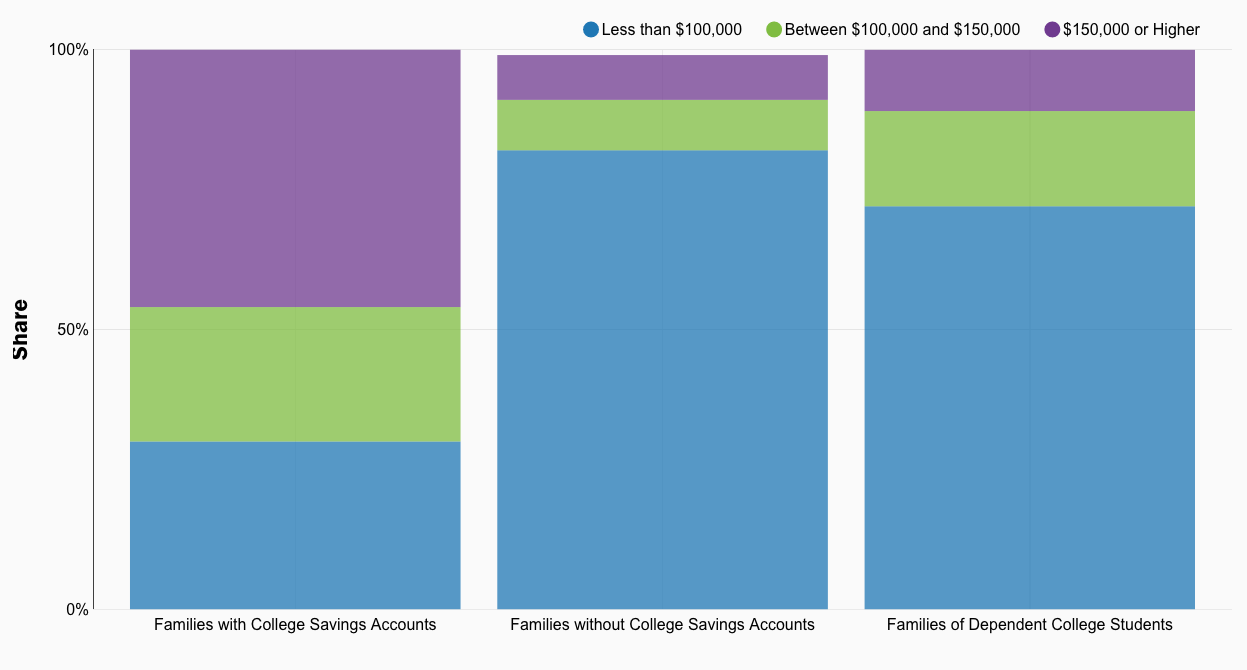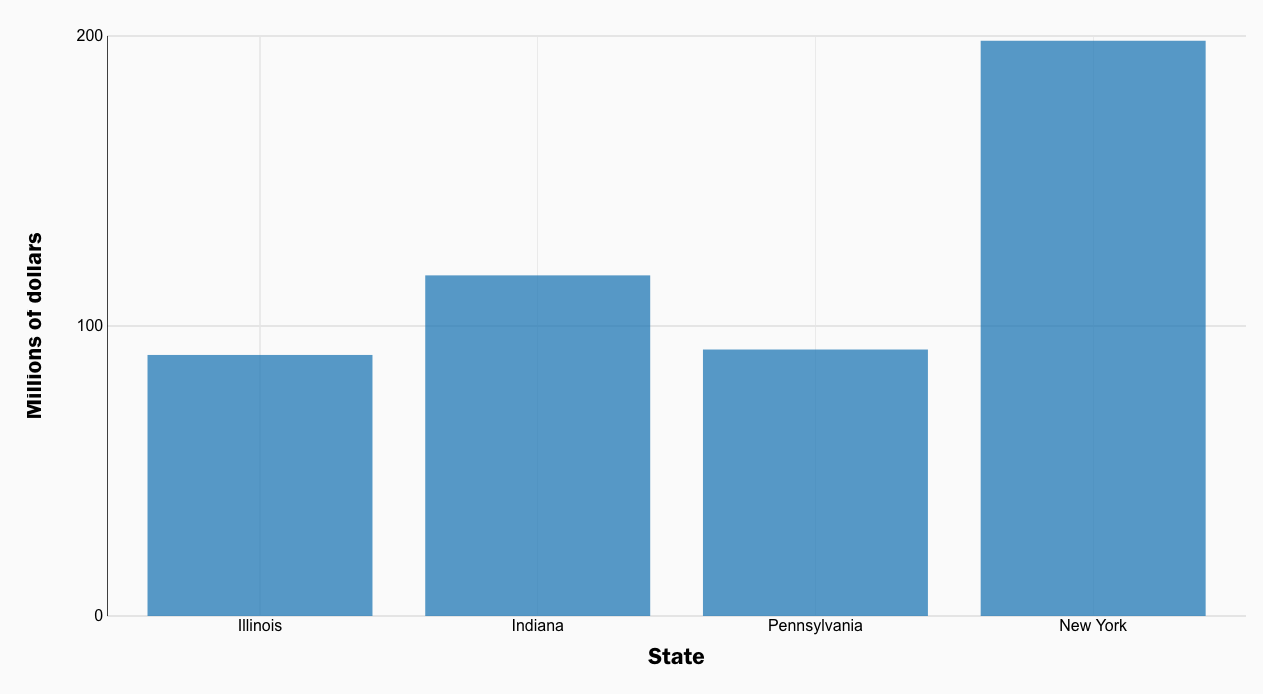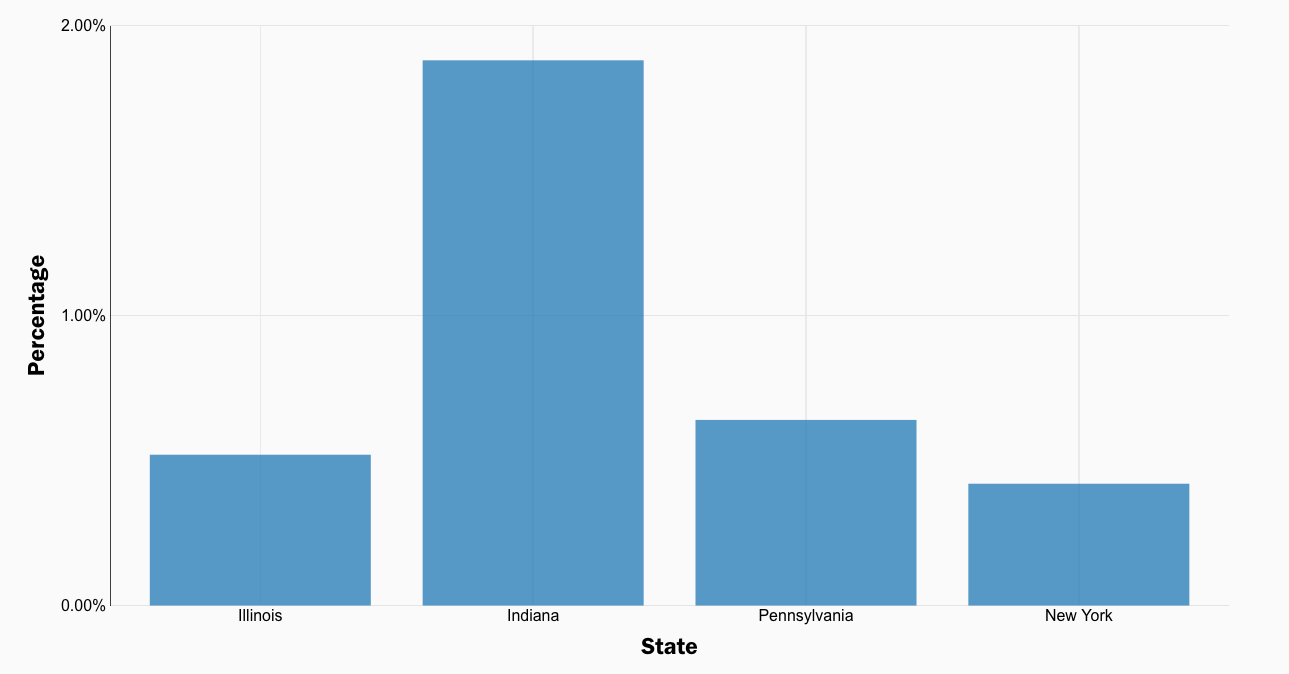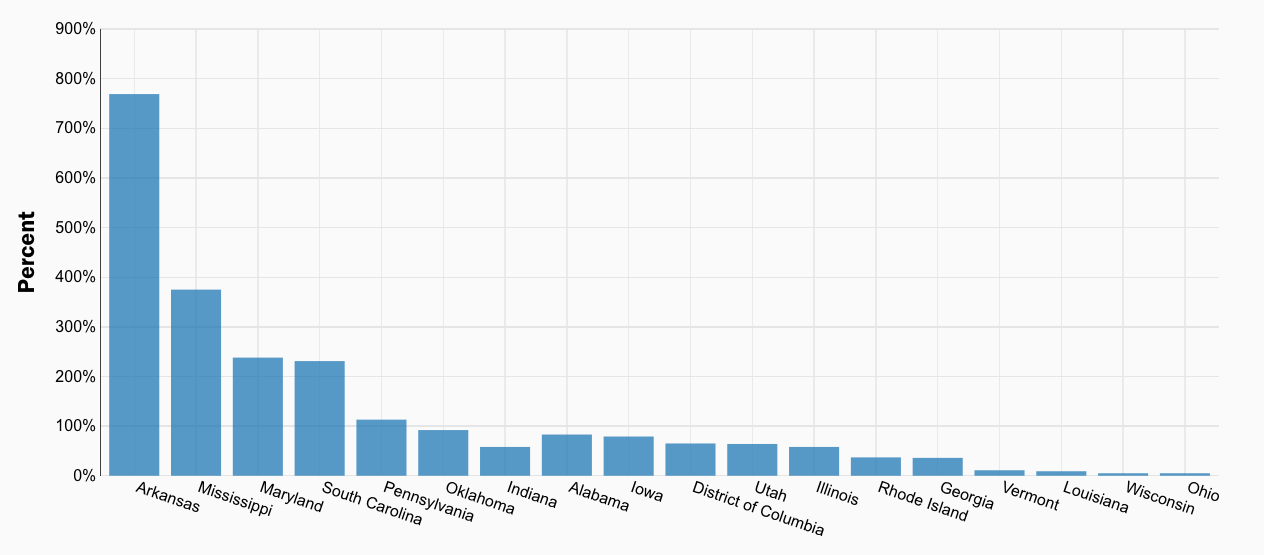
Executive Summary
The Tax Cuts and Jobs Act substantively changed 529 college savings plans. In an effort to promote school choice, the Act expanded the list of eligible 529 expenses to include K-12 private school tuition. This federal change in the definition of qualified expenses will impact many states, particularly those that offer 529 tax deductions and credits. In this paper, we examine the potential impact of the 529 expansion on the distribution of benefits across families, on the promotion of private school choice, and on possible fiscal implications for individual states. Our overall assessment of the likely impact in these three areas is that the 529 expansion to private K-12 schools will primarily benefit affluent families, produce limited incentives for promoting private school choice, and come at a nontrivial cost to states. We discuss some ways that states might respond to promote progressive tax policy and expand private school choice. A simple roll-back of state tax breaks, and/or direct investment in school choice end up as the most straightforward ways to achieve these goals.
Overview
The Tax Cuts and Jobs Act of 2017 (TCJA) made a dramatic change in education-related federal tax law with serious consequences for many states. Funds from 529 accounts, which formerly could only be used for college expenses, can now be used to pay tuition for students attending private K-12 schools – up to $10,000 per year per student. This change, which was added to the bill in the 11th hour (it was previously proposed and then reemerged as an amendment on final passage), is intended to promote private school choice, a goal that Congress had displayed little appetite for tackling head on.
Here we consider the potential costs of the program to states; whether the financial benefits that flow to parents will be equitably and efficiently delivered; the extent to which the program is likely to achieve its intent of expanding the proportion of the K-12 student population attending private schools; and some of the choices states have in adapting their state plans to the new federal law.
The key benefit of 529 plans is that earnings on contributions are not subject to federal taxes when withdrawn to pay for tuition and other select college expenses. When earnings from 529 contributions accrue over long time periods as they do, for example, when parents establish and fund a 529 plan when their child is young and begin to draw it down when that child enters college, the financial benefit of exemption from federal taxes can be substantial. [1] However, the time period between putting money into a 529 plan and withdrawing it for K-12 tuition will typically be far shorter. The Joint Committee on Taxation (JCT) estimates the loss to the Federal Treasury will be a modest $600 million over 10 years. [2]
The federal tax code defines 529s and the expenses they may be used for, but states run the plans. All but two states, Washington State and Wyoming, offer 529 plans. Most importantly, more than 30 states offer state-level tax deductions or credits, which can be claimed on each year’s state tax return, for those who put money into the plans. These immediate state-level tax benefits are what will almost certainly draw more people who are paying private school tuition into 529 accounts – any family paying private school tuition in a state offering 529 tax benefits would be foolish, financially speaking, not to make use of them. The rub is that as more families start claiming the benefits, state revenues will decline.
More than two months after the passage of the TCJA, many states are still uncertain as to how they will accommodate this federal change in definition of qualified expenses. Most states will have to respond in some way—by changing state regulations or laws to block or welcome the expansion and by communicating those options to account holders. At last count, of the 34 states with 529 deductions or credits, eighteen automatically conformed or have passed legislation to conform to the federal 529 change, while sixteen have either argued that their state 529 incentives cannot be used for K-12 expenses, despite the federal change, or have yet to determine their course. [3] For some of these states, this could include new legislation that constrains the state tax benefits in their own specific 529 plan (an option we discuss below).
The real question for states is whether they wish to use their own tax systems to support spending on private K-12 education through the vehicle of 529 plans. The answer to this question will clearly vary, depending on the political complexion of a state government, financial implications, and broader attitudes towards school choice. We focus on the fiscal implications for states (the cost to tax payers), distributional consequences for families (who will financially benefit most), and the potential for promoting private school choice. Our overall assessment of the likely impact in these three areas is that it will hit state revenue, largely help affluent families, and have only a limited positive impact on private school enrollment.
We describe these three broad consequences of the 529 expansion, before turning to some options for states who may wish to reduce the regressive effect of the change, and/or to bolster private school choice more effectively.
Consequence #1: A regressive distributional impact
Prior to the policy change, the state tax benefits of 529 plans flowed largely to more affluent families. The share of financial benefits flowing to relatively wealthy families under the K-12 expansion is likely to increase for three main reasons:
• Families with the funds to save skew towards the higher end of the income distribution.
Even before the TCJA reforms, the benefits of 529 plans were greatest for more affluent families. According to analysis from the College Board that uses a Government Accountability Office (GAO) report and the National Postsecondary Education Student Aid study, 47 percent of families in 2010 with 529 plans had an annual income of over $150,000: [4]
Income distribution of families with and without College Savings Accounts, 2010
Source: “Figure 2015_32A: Income Distribution of Families With and Without College Savings Accounts.” CollegeBoard. https://trends.collegeboard.org/student-aid/figures-tables/income-distribution-families-and-without-college-savings-accounts.
The change in the federal tax code is certain to induce more families to open 529 accounts if they have children in private K-12 schools. But these are households that are, if anything, even more likely to have high incomes than even existing 529 account holders. Children from affluent families are much more likely to attend private schools than those from middle-income or low-income households; and the gap has been widening in recent decades (likely a reflection of broader economic inequality).
• The tax break is worth more to higher income households.
Tax incentives delivered in the form of a reduction in taxable income are also more valuable for those in higher tax brackets and with higher tax burdens. Imagine two Maryland families: one is a low-income family with a state income tax rate of 2 percent; the other is a wealthy family facing the highest marginal income tax rate of 5.75 percent. If these families saved the same amount into a 529 account, say $10,000, the higher income family would see a bigger financial benefit ($575 for them versus $200 for the lower income family).
• Non-refundable tax benefits exclude families with the lowest incomes.
Unless tax benefits are refundable (payable to a taxpayer as a refund if the credit is larger than the tax owed), families with the very lowest incomes and tax bills cannot gain any benefit. For example, one analysis found that a two-parent Nebraska family would have to earn $30,400 to get any 529 benefit at all; to get the full benefit the same family would have to earn $40,400, and put a quarter of total income into a 529. [6]
529 plans, then, are already highly regressive in terms of their distributional impact, both at the federal and state levels. By drawing more affluent families towards 529 accounts, the latest reform is almost certain to make the overall impact even more regressive, unless states change their tax treatment. In practice, the new law will simply mean more money flowing from state treasuries into the bank accounts of affluent families.
Consequence #2: Inefficient promotion of school choice
The 529 expansion has been called a major advance for school choice, or in the words of the reform’s sponsor Senator Ted Cruz, “The most significant school-choice legislation in history.” [7] Certainly it is a departure from existing school choice programs. Until the TCJA, private school choice programs have been primarily state-led. The majority have been designed to make private school options available to families that otherwise could not afford them, to students “trapped in failing schools,” or students with special needs. The 529 expansion is a marked departure from targeted private school choice programs in two ways.
First, as noted in the previous section, the distributional characteristics of the benefit are heavily tilted to affluent families who have a significant state tax burden and can save for private school tuition. Thus, the program does little or nothing for parents who wish to send their child to a private school but are of limited means.
Second, the new 529s are likely to be only marginally effective in increasing the private school share of students. Current private school families, not new choosers, are most likely to take advantage of these tax benefits. Nationwide, nearly 5 million children (around 10 percent) are enrolled in private schools. [8] Currently, very few of their parents have 529 accounts. In fact, recent data indicates only 7 percent of families expecting major educational expenses in the next 5-10 years hold 529 accounts. [9]
But this could change quickly. More than three in five private K-12 students live in states that offer deductions or credits for 529 contributions. [10] For these families, the expansion brings short-terms benefits from 529 plans that once laid in the distant future – deposit money in a 529 in December, withdraw it a few days later to pay the spring semester’s tuition at your child’s private school, and then collect the tax benefit with your tax filing in April. Existing private school families should open and contribute to 529 plans in droves.
To be sure, the 529 expansion will expand school choice to the relatively few families on the margin. Most short-term 529 state tax benefits are between 5 and 10 percent, meaning that families for whom a 5-10 percent tuition discount would make the difference, could be induced to choose a private school. For each family that newly embraces choice, there are many more already in private school that will also take the state income tax savings. If the end goal is to expand school choice, a 529 expansion is a very inefficient way to achieve it.
Consequence #3: Lost State revenues
What will be the impact of the 529 reform on state tax revenues? The total loss depends on the proportion of current private school families who use 529 plans for private school tuition, how many families switch from public to private schools, and on the generosity and stability of state tax incentives. One of the authors, Malkus, estimates that the cumulative state income tax liability [11] could be over $900 million per year, with the biggest hits in New York, Indiana, Pennsylvania and Illinois:
State revenue losses from 529 expansion, millions of dollars
Source: Calculations by Nat Malkus of revenue losses from 529 expansion to K-12 expenses
State revenue losses from 529 expansion, as a percentage of income tax receipts
Source: Calculations by Nat Malkus of revenue losses from 529 expansion as a share of current K-12 school choice expenditures
As a proportion of overall state budgets, these estimates are low in percentage terms. But in dollar terms, they are not trivial especially given that little of the money will drive any change in behavior.
Opponents of taxpayer support of private schools choice are likely to oppose tax subsidies of any kind of course. But even school choice supporters, including in states that have existing programs, can reasonably doubt whether investing scarce state dollars in 529 expansion is the right approach. In many states, the costs of the 529 change are likely to be sizable, especially compared to current state school choice program expenditures. Indiana’s loss is estimated at $117 million, almost as much as the $131 million spent on the Indiana Choice Scholarships in 2015-16. [12] Pennsylvania’s 529 liability is about $92 million a year, which is actually more than the state currently spends on two tax-credit scholarship programs. [13]
529 tax liabilities as percentage of existing state private school choice expenditures
Source: Calculations by Nat Malkus of revenue losses from 529 expansion as a share of current K-12 school choice expenditures
There is a sharp question to be answered by pro-private school choice state policymakers: Are 529s for K-12 the place to spend school choice dollars?
Policy options for states
If state policymakers want to dampen the regressive distributional effects of the 529 expansion, or enhance its impact on school choice, or both, what options do they have? We examine and evaluate several options—some of which state leaders and 529 plan administrators have discussed with us.
Restrict state 529 plan to post-secondary spending
A state could pass legislation or take regulatory action restricting qualified expenditures in its own state 529 plan to post-secondary options. This would essentially return the state 529 plan to its status prior to the passage of the tax bill.
Remove state tax incentives
States could simply scrap their tax deductions on 529 savings. As we have noted above, these deductions largely benefit the wealthiest citizens of the state. And as we demonstrated in the previous section, the risk to state revenues from greater take-up of 529 accounts is not trivial. Scrapping the deductions would likely lead to lower take-up of 529 plans, as the experience in North Carolina [14] which removed its tax incentives starting in 2014, suggests.
Several states with 529 plans, such as California, do not provide additional tax incentives, but removing benefits that are already in place can be a political challenge. A state pursuing this option would face political opposition of current 529 holders. But it may be even harder to roll back these incentives in future years as families increasingly use them to fund private K-12 school tuition. Eliminating state tax incentives would save a state money and remove some regressivity in its tax code.
Reduce state tax incentives
A softer option is to reduce the value of state tax benefits. State lawmakers might wish to maintain some form of tax-advantaged higher education savings mechanism. But they could reduce the size of the deduction or phase it out for higher-income families. On the one hand, such a reduction could make the system marginally more progressive by cutting benefits at the top. On the school choice-side, it would potentially limit liability from unbounded expansion, allowing more school choice dollars to go to more targeted programs.
Introduce a minimum holding period
Some state leaders have considered introducing a minimum holding period for 529 contributions, requiring account holders to keep funds in an account for a specified period of time in order to qualify for tax benefits. In many states, families can make use of a “touch the toes” rule with funds only needing to sit in 529 plans for a very short period of time; for example, in New York funds need to sit for only 10 calendar days. If the goal is to encourage saving, such lax holding requirements are nonsensical.
States with a substantial holding period are the exception, though Minnesota may be the only one. [15] There is nothing to stop states requiring funds to remain in 529 accounts for a longer period – perhaps even for a number of years. This would lessen the immediacy of the tax benefits and may reduce the number of families making use of the new private K-12 allowable expenditure. On the other hand, an extended holding period would make 529s a more cumbersome instrument and may further deter lower-income families from making use of them.
Convert 529 tax deductions into credits
States could also consider making 529 tax deductions into tax credits as states like Indiana already do (Minnesota offers both). Contributions to 529 plans then reduce a household’s tax liability by the same amount regardless of income, turning a regressive scheme into a more progressive one.
There are some serious downsides, however. For one thing, it is more expensive, precisely because so many more families can benefit. Another is that even though credits can help a broader range of families, the sums involved are too small to do much to promote school choice. Even a generous 529 credit, such as Indiana’s $1,000 maximum, is not likely to be enough to attract many more families into the private K-12 sector.
Introduce refundable 529 tax credits
States could take the tax credit approach a step further by making them fully refundable so that low income families whose tax liability is less than the credit would receive the remainder as a tax refund. Currently no states offer this, and though potentially expensive, a refundable credit would deliver larger benefits to the lowest income families without increasing state expenses to wealthier families. Once again, while this increases the benefits of 529s at the bottom in a targeted manner, it comes with a hefty price-tag, and, unless the credits were quite large, is unlikely to move the needle on promoting school choice.
Matching benefits to savings
A final option, and potentially the most expensive, would be for a state to match a tax benefit to the amount a family saves, either in cash terms or as a proportion of household income. Nevada offers a matching benefit of up to $300 a year for families with annual incomes below $75,000 saving into a 529 account for a child 13 years or younger. [16] A state could, for example, provide a tax credit of $500 per individual ($1,000 per married couple) to a family saving at least 1.5 percent of their reported income into 529 plans, perhaps limited to lower income households. The idea here is to provide an equal reward to all low and middle income families saving at the same rate measured against their income.
Conclusions
The truth is that 529 accounts do not offer an effective vehicle for promoting private school choice. This is for three reasons.
First, 529s are investment vehicles intended to promote long-term savings rather than year-to-year spending. Exempting earnings from federal taxes on earnings will be of little value to a family drawing funds out to pay K-12 school tuition on a regular basis. In fact, it is the state tax benefits that make the real difference here, which suggests that the reform won’t pack much of a punch in states with no deduction/credit for 529 contributions, or those with small ones. However, as we argue above, those states that do offer substantial incentives are likely to run into real costs as a result.
Second, 529 accounts are almost by definition likely to be more valuable to more affluent families. States offering significant tax incentives on 529 contributions will essentially be giving families the chance to cut the cost of private K-12 schools by 5, 10 or even 20 percent. Take up of 529 accounts in the most generous states could double. Most of the gains will accrue to families who already have the means to pay private school tuition and are doing so. But the goal of most state private school choice programs is to draw children from less affluent families into good quality, tuition based private schools. Some of the options outlined in this paper, if pursued aggressively, could make 529s more beneficial for low and middle income families, but none get close to offering benefits high enough to bring private K-12 tuitions within their reach.
Third, the reforms necessary for 529 accounts to offer real advantages to less affluent families paying for private K-12 education would result in a complex system. Complexity deters parents from participating, especially those who are less equipped to navigate financial intricacy. In short, even if a state legislature wants to invest in private school choice, doing so through the tax treatment of 529 plans is, at best, an indirect and convoluted approach.
529 plans were flawed before the 2017 tax reforms. They were regressive when they were restricted to college expenditures; expanding them to include private K-12 schools will simply make them more so. They are also a highly inefficient, indirect and convoluted means for promoting school choice. The reform amounts to a substantial increase in public financing for private K-12 schooling, while doing little to meaningfully increase school choice.
— Nat Malkus, Richard V. Reeves and Nathan Joo
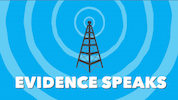 Nat Malkus is a resident scholar and the deputy director of education policy at the American Enterprise Institute. Richard V. Reeves is a senior fellow in Economic Studies and co-director of the Center on Children and Families. at Brookings. Nathan Joo is a Senior Research Assistant at Brookings.
Nat Malkus is a resident scholar and the deputy director of education policy at the American Enterprise Institute. Richard V. Reeves is a senior fellow in Economic Studies and co-director of the Center on Children and Families. at Brookings. Nathan Joo is a Senior Research Assistant at Brookings.
This post originally appeared as part of Evidence Speaks, a weekly series of reports and notes by a standing panel of researchers under the editorship of Russ Whitehurst.
The author(s) were not paid by any entity outside of Brookings to write this particular article and did not receive financial support from or serve in a leadership position with any entity whose political or financial interests could be affected by this article.
Notes:
1 Richard V. Reeves and Nathan Joo. “A tax Break for ‘Dream Hoarders’: What to do about 529 college savings plans.” Brookings Institution. June 29, 2017. Available at https://www.brookings.edu/research/a-tax-break-for-dream-hoarders-what-to-do-about-529-college-savings-plans/
2. “Estimated Revenue Effects of HR 1, The ‘Tax Cuts and Jobs Act’.” Joint Committee on Taxation. November 2, 2017. Available at https://waysandmeansforms.house.gov/uploadedfiles/jct.pdf.
3. “Using Savings Plans for K-12 Tuition.” ExcelinEd. February 2018. Available at https://www.excelined.org/wp-content/uploads/2018/02/ExcelinEd.EdChoice.AFC_.529ExpansionMemo.February2018.pdf
4. “Figure 2015_32A: Income Distribution of Families With and Without College Savings Accounts.” CollegeBoard. https://trends.collegeboard.org/student-aid/figures-tables/income-distribution-families-and-without-college-savings-accounts
5. See http://www.nber.org/papers/w23571.pdf
6. See https://itep.org/higher-education-income-tax-deductions-and-credits-in-the-states/
7. Ted Cruz. “Cruz: Texans benefit from tax-reform bill with education savings.” December 2017. Available at http://www.star-telegram.com/opinion/opn-columns-blogs/other-voices/article192019249.html.
8. See http://www.capenet.org/facts.html
9. See https://www.cnbc.com/2015/01/28/529-plans-the-real-users-and-what-they-sock-away.html
10. Authors’ calculations from Stephen P. Broughman, Adam Rettig, and Jennifer Peterson. “Characteristics of Private Schools in the United States: Results From the 2015-16 Private School Universe Survey.” (Washington DC: US Department of Education, August 2017). NCES Table 15. Number of private schools, students, full-time equivalent (FTE) teachers, and 2014-15 high school graduates, by state: United States, 2015–16.
11. This estimate assumes full use by existing private school families (likely an upward bias) and no additional adoption by public school families (likely a downward bias).
12. See https://www.doe.in.gov/choice
13. This includes the Opportunity Choice Scholarship and the Educational Improvement Tax Credit Program. For more details, see https://www.edchoice.org/school-choice/state/pennsylvania/.
14. Elaine S. Povich. “In some states, new benefits for 529 savers.” March, 2014. USA Today. Available at https://www.usatoday.com/story/news/nation/2014/03/18/stateline-benefits-savings-college/6557905/.
15. See https://www.revisor.mn.gov/bills/text.php?number=HF1&version=1&session=ls90&session_year=2017&session_number=1
16. See https://www.ssga.upromise529.com/home/nevada-benefits/silver-state-matching-grant.html


